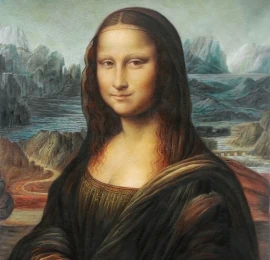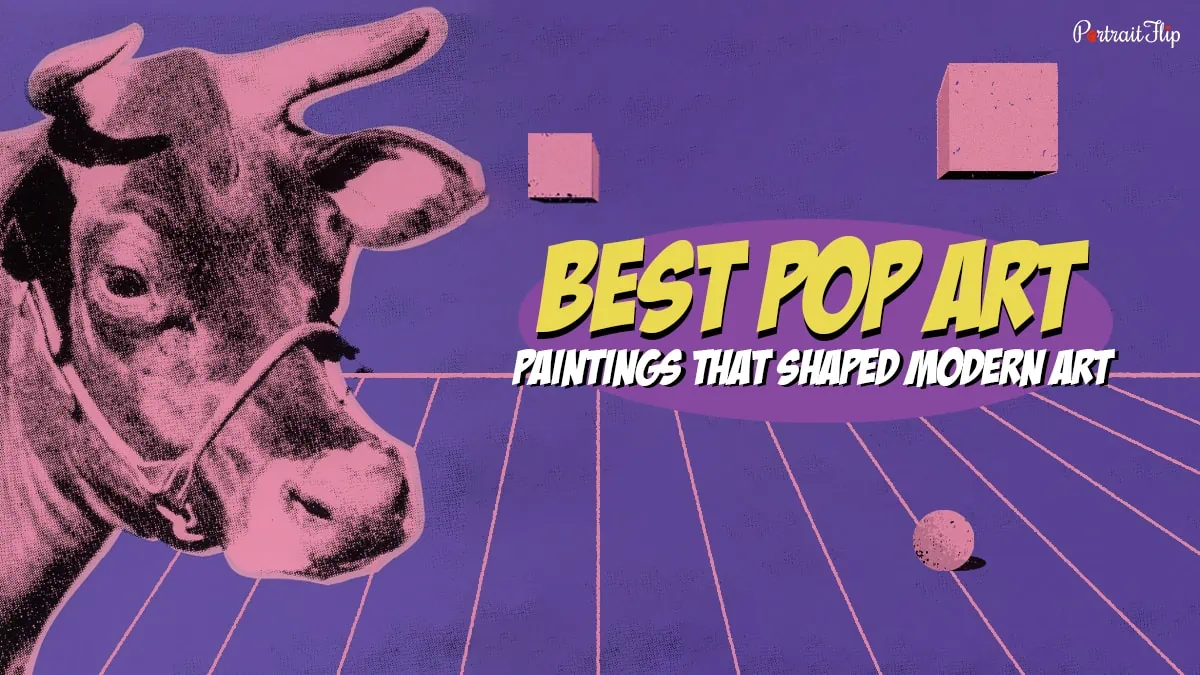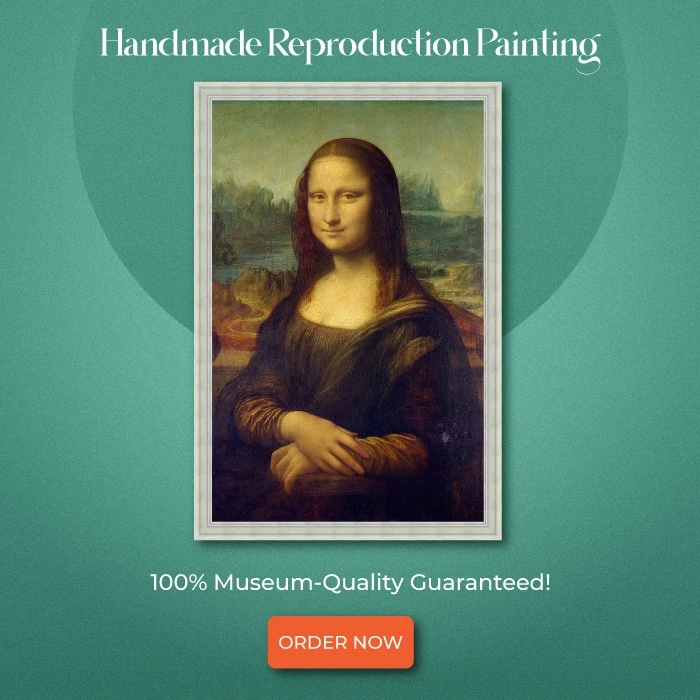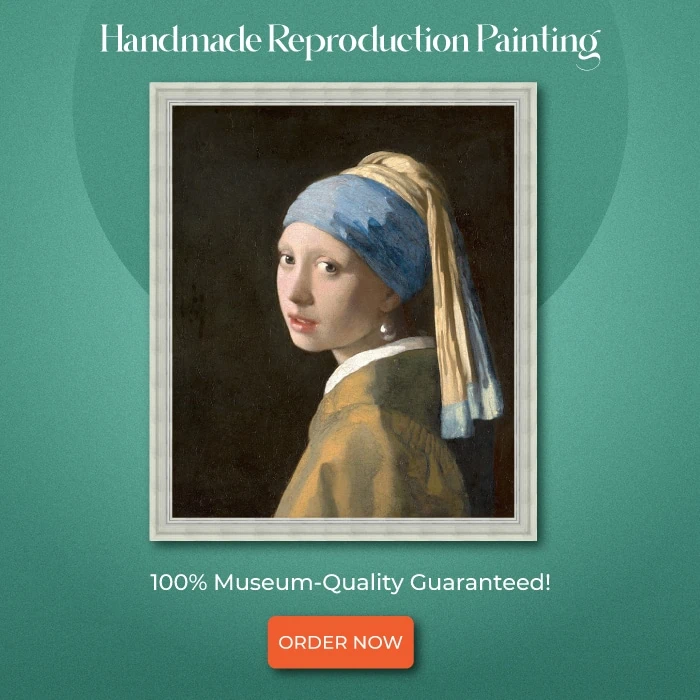Have you ever seen the advertisements, comics, books, or newspapers from the 1950s?
Back when the USA and the UK were adapting the concept of pop art, the paintings and imagery started getting mass attention from the audience.
Do you know why? Because of their uncanny and vibrant depictions.
Pop art paintings were often compared to abstract artworks, but they were mainly considered an amalgamation of both radical and shocking artworks.
With the hidden message of taunting society and covering the darker depths of societal taboos, pop art paintings have come a long way.
With this said, I have compiled a list for you that consists of some of the most famous pop art paintings.
Table of contents
- What is Pop Art?
- 1. Look Mickey
- 2. A Bigger Splash
- 3. Radiant Baby
- 4. Crack is Wack
- 5. Still Life #35
- 6. Brillo Box
- 7. Marilyn Diptych
- 8. I Was a Rich Man’s Plaything
- 9. Drowning Girl
- 10. President-Elect
- 11. Just What Is It That Makes Today’s Homes So Different, and So Appealing?
- 12. Flag
- 13. Whaam!
- 14. On The Balcony
- 15. Campbell’s Soup Cans
- Conclusion
- Author’s Note
- Frequently Asked Questions
What is Pop Art?
Pop art was the outcome of a crucial artistic movement that dominated the middle of the 20th century.
The motto behind the pop art movement was that it appreciated and praised popular culture over elite culture.
It is also a fact that Dadaism is somewhere considered the ancestor of pop art, which featured various renowned artists of Dadaism.
There were many pop artists who wanted to prove that sources from popular and commercial culture could challenge traditional notions of art.
Ads, celebrities, everyday cultural artifacts, and comic book characters, provided most of the inspiration.
Here are some of the most famous pop art paintings that still reign in the art world today.
Suggested Read: Pop Art Movement
1. Look Mickey
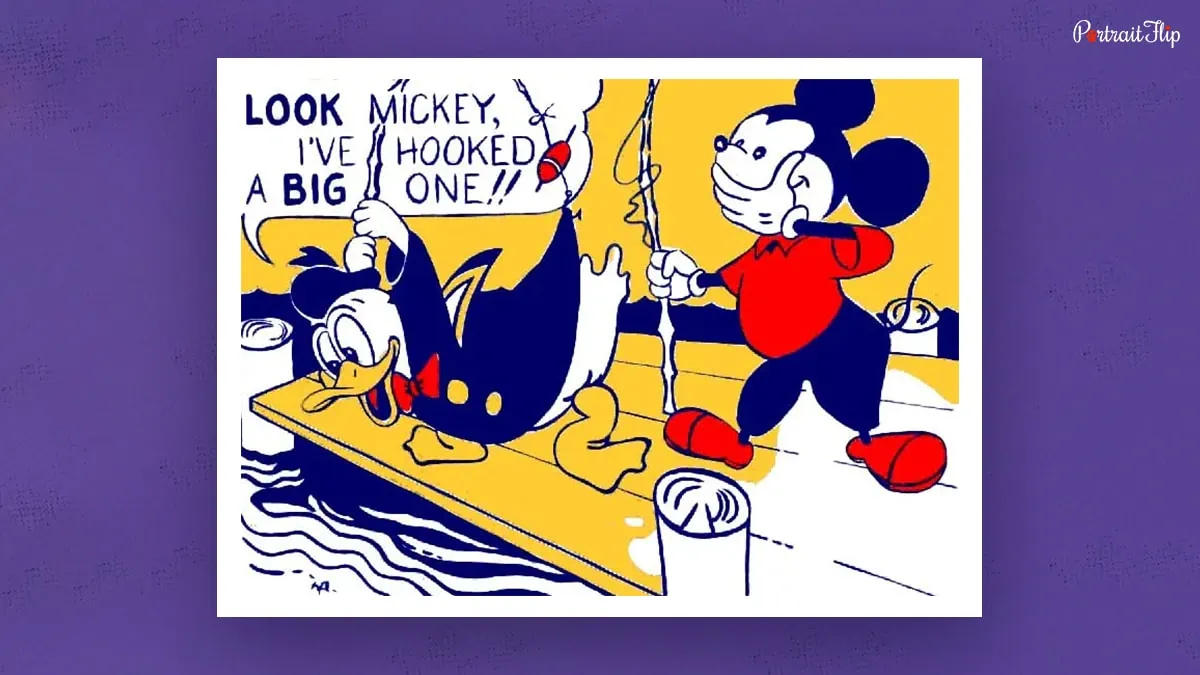
| Artist | Roy Lichtenstein |
| Year | 1961 |
| Dimensions | 121.9 cm x 175.3 cm |
| Medium | Oil on Canvas |
| Estimated Cost | $95 million at Christie’s auction (2015) |
| Location | National Gallery of Art, Washington, DC |
Look Mickey is an astonishing pop art painting by Roy Lichtenstein.
This painting acted as a bridge between his abstract expressionism and his most famous pop art pieces.
The artwork is known for its aesthetic value and humor.
Look Mickey is Roy’s first full use of all the painting techniques that he could incorporate to produce a replica of a comic strip.
For the first time, there is a painting that depicts the use of Ben-Day dots to give texture to a pop art painting.
Roy portrayed the fishing mishap and modified it as well as the original source of the painting.
Critics regarded Look Mickey as revolutionary for the future of modern art and pop art culture in general.
2. A Bigger Splash

| Artist | David Hockney |
| Year | 1967 |
| Dimensions | 242.5 cm x 243.9 cm |
| Medium | Acrylic on Canvas |
| Estimated Cost | £23.1 million is at auction in London |
| Location | Tate Britain, London |
A Bigger Splash is David Hockney’s famous pop art painting.
After relocating to Los Angeles, Hockney learned that every home had a pool.
Therefore, he painted a number of images of swimming pools outside of houses between 1964 and 1971.
Now you know where the inspiration came from.
The show contrasts Hockney’s hectic life in New York with a calmer life in California.
His constant goal was to experiment with new techniques to mimic the constantly shifting water’s surface.
He understood that acrylic dried more quickly than oil paints. Hence, the paint produces vivid and suburban scenes.
David created “A Bigger Splash” from a book illustration based on swimming pool construction.
The background depicts a drawing of buildings found in a rural area of California.
Although there are no humans in the artwork, the splash made on the pool’s surface implies that there might have been.
The chair and a palm tree make up the majority of the image.
(Also Read: Rothko’s No. 61)
3. Radiant Baby
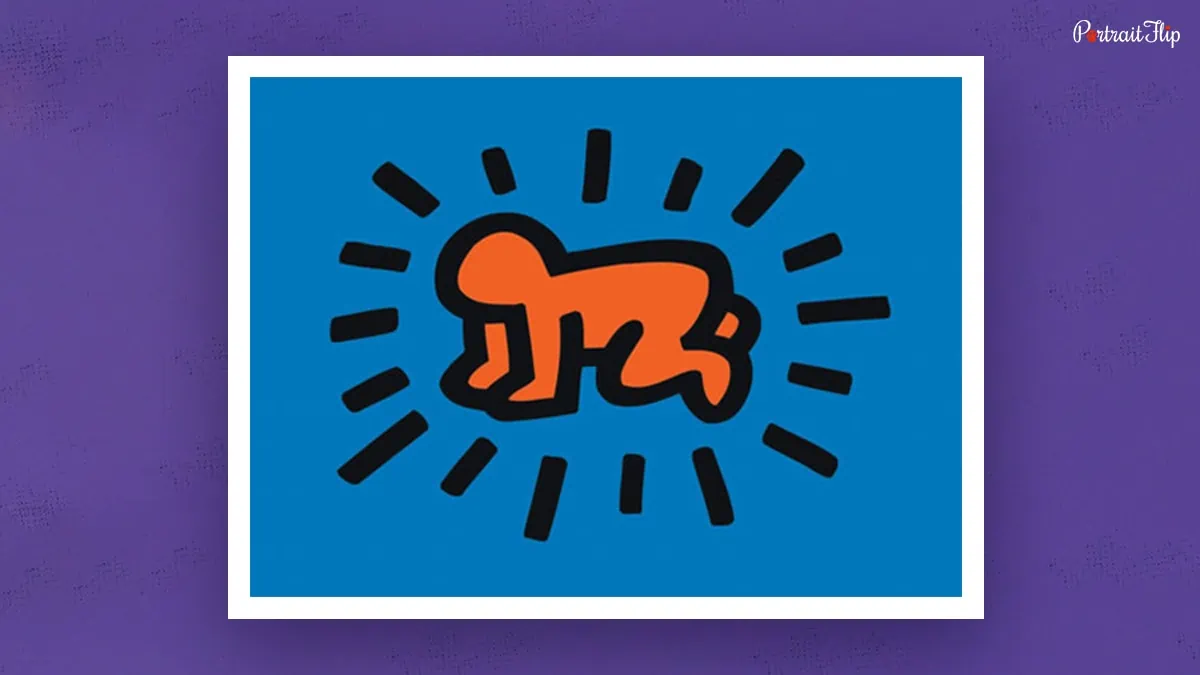
| Artist | Keith Haring |
| Year | 1990 |
| Dimensions | 53.34 x 63.5 cm |
| Medium | Paint Pen |
| Estimated Cost | £19,000 – £29,000 (1990) |
| Location | Missing |
Here comes another famous pop art painting of all time—Radiant Baby. This art piece depicts the silhouette of a baby crawling.
But don’t you love the glow of the baby in the picture?
You must be wondering, What am I talking about? There is no essence to shine or glow.
Well, Keith Haring was a genius. Do you know why?
The black lines in the painting are a way to depict the baby in the limelight.
For Keith, the baby symbolizes the emanating nature of life and energy.
She took the baby as a historical resemblance of innocence and fresh starts. A thoughtful pop art, I must say!
The full premiere of “Radiant Baby” took place at the Public Theater in 2003.
4. Crack is Wack
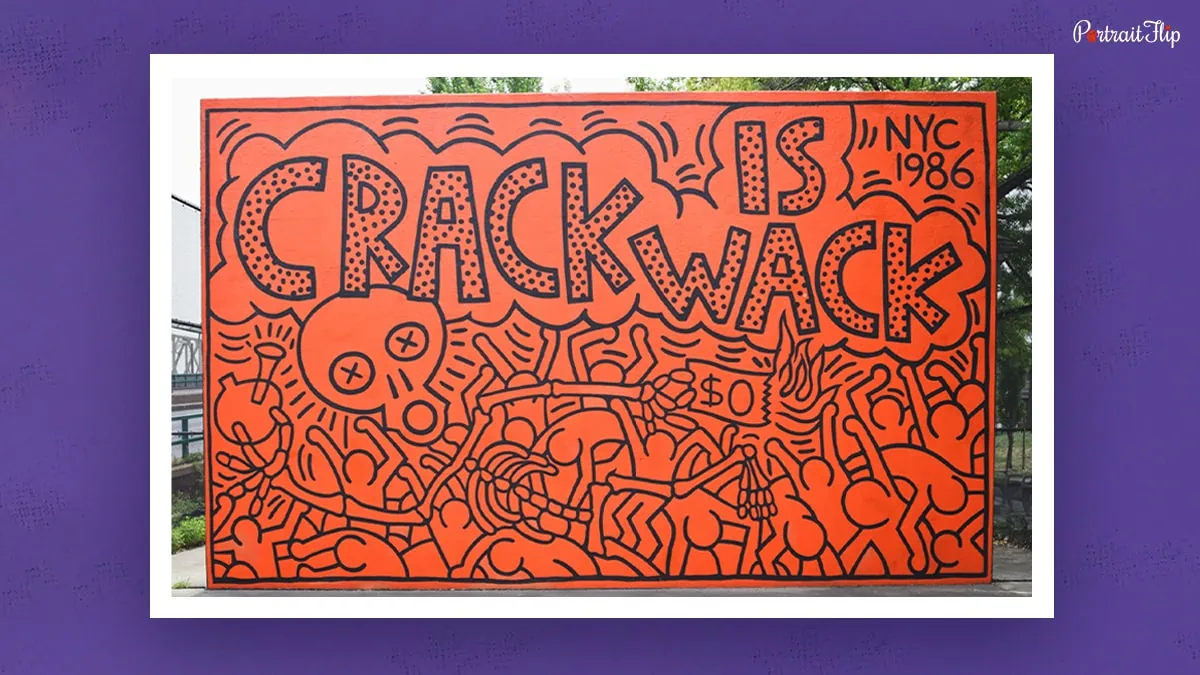
| Artist | Keith Haring |
| Year | 1986 |
| Dimensions | 487.68 cm x 792.48 cm |
| Medium | Painting, Mural |
| Estimated Cost | $6.5 million at Sotheby’s auction (2017) |
| Location | East Harlem, New York |
Another Keith Haring? No doubt, her pop art paintings are a must to glance at!
“Crack is Wack” is a street mural painting created in 1986.
This mural art is a warning sign against the use of cocaine and is one of the most famous anti-drug artworks.
Keith created this mural when the US experienced the widespread use of illegal drugs and trafficking.
This pop art painting was a frontline fighter for the US government’s war on drugs.
An interesting fact about Crack is Wack: Keith got arrested multiple times for vandalizing public property while making these artworks on the walls.
The versions were altered while making, yet one of the two previous murals still stands in East Harlem, New York.
5. Still Life #35

| Artist | Tom Wesselmann |
| Year | 1963 |
| Dimensions | 120 in x 192 in |
| Medium | Oil and Collage on Canvas |
| Estimated Cost | $10.7 million at Sotheby’s auction (2008) |
| Location | Denver Art Museum |
The most interesting part about this collage is that Tom Wesselman (the artist) disavowed any connection to the movement.
The artwork you witness above includes white bread, a bottle of Coke, a can of stew, lemons, and a pack of cigarettes.
All are emblematic of America during the middle of the 20th century.
Due to the saturation of color throughout the frame, all of the subjects appear manufactured or fictitious to the viewer.
The painting has a landscape-like feel to it because the artist has depicted a jetliner flying outside the window over an emerald ocean surface.
It concealed all the anxiety and suffering that permeate their lives.
It creates the illusion of a joyful and carefree reality offered by the American dream.
6. Brillo Box
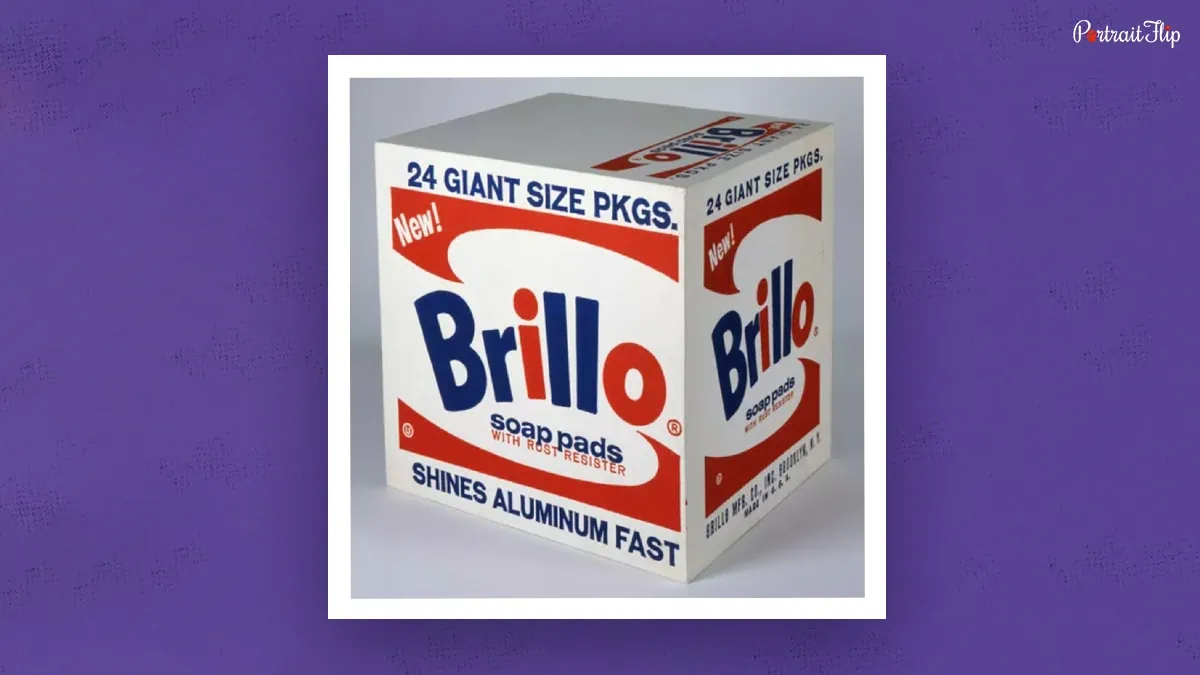
| Artist | Andy Warhol |
| Year | 1964 |
| Dimensions | 17 × 17 × 14 inches (43.2 × 43.2 × 35.6 cm) |
| Medium | Screenprint and ink on wood |
| Estimated Cost | Sold for $710 million at Christie (2006) |
| Location | National Gallery of Canada |
Have you ever seen the commercial packaging offered by “Brillo?”
Andy Warhol had accurately portrayed the same compositions in his “Brillo Box.”
The piece conveys a message for viewers to engage with life and consider what they value and perceive in art.
Warhol used a variety of painting styles and techniques to create numerous boxes of Brillo over the course of his artistic career.
To make his art seem mass-produced, he sold these pieces to various museums, galleries, and collectors.
Even then, the placement and lighting of each of Andy’s Brillo Boxes are distinctive; no two are alike.
He called his workshop “The Factory” because he produced his artwork in large quantities while attempting to avoid the commercial world.
7. Marilyn Diptych

| Artist | Andy Warhol |
| Year | 1962 |
| Dimensions | 205.44 cm × 289.56 cm |
| Medium | Silkscreen ink and acrylic paint on canvas |
| Estimated Cost | $195 million at Christie |
| Location | Tate, London |
Here is another Andy Warhol creation, “Marilyn Diptych.”
It was painted as a tribute to Marilyn Monroe (an American actress) and was also chosen as the third most important contemporary artist.
Marilyn Monroe had everyone enthralled, including Andy.
She was a well-known figure in pop culture, and Andy’s work was regarded as one of the most well-known pop art examples to explicitly reference her.
Marilyn’s photograph from a 1953 publicity photo shoot for the movie Niagara served as the basis for this multi-canvas composition.
It is one of the most famous pop art portraits, regardless of one’s familiarity with the movement.
If you notice, the piece of art is divided into two sections covered with fifty images of the actress.
The diptych design on the left column is a tribute to the saintly qualities of the well-known individuals, which gave them the reputation of being holy and eternal.
This pop art painting is created in vibrant, bright colors with an overlaying silkscreen effect.
On the other hand, the right column is left in grayscale and gradually fades out.
8. I Was a Rich Man’s Plaything
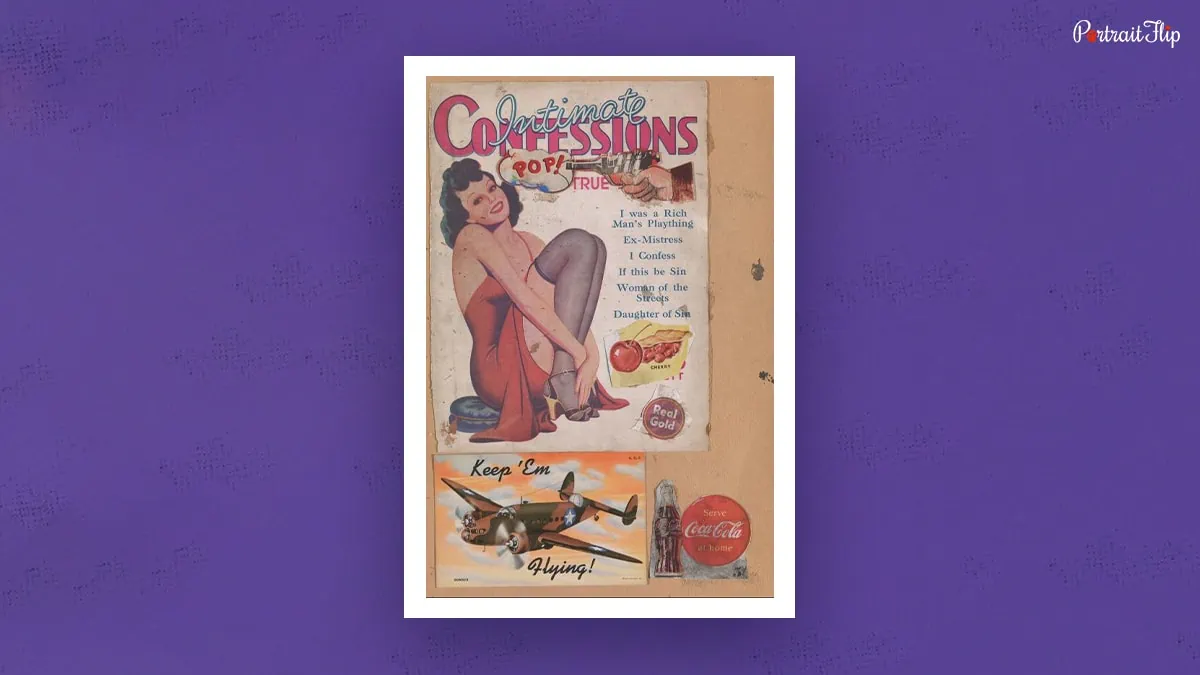
| Artist | Eduardo Paolozzi |
| Year | 1947 |
| Dimensions | Collage – 14¼ x 9¾ (36 x 25) |
| Medium | Collage |
| Estimated Cost | Not Disclosed |
| Location | Tate Gallery |
Eduardo Paolozzi was a leader and an essential component of the British avant-garde after World War II.
Some of the earliest examples of the yet-to-emerge pop art styles were produced by him.
As a member of the nebulous Independent Group, Paolozzi focused on how technology and popular culture affect high art.
A pulp fiction book cover, a Coca-Cola commercial, and a military recruitment poster were all collaged together to create the piece “I Was a Rich Man’s Plaything.”
The “Intimate Confessions” magazine cover is the most noticeable component of the collage, which makes up the top two-thirds of the piece.
By sticking a gun with the word “pop” on it, this piece of pop art was the first to do so.
It is widely acknowledged that this collage, which is Paolozzi’s most well-known piece, was the first Pop Art movement standard bearer.
His collage “I Was a Rich Man’s Plaything” served as an essential Pop Art movement cornerstone piece.
Due to the misogynistic and violent tone of its content, the piece gives away a contemporary perspective and even highlights some troubling issues.
This iconic pop art piece only shows women as objects for male sex.
In today’s politically correct environment, even the gun aimed at the woman’s head would be unpopular.
9. Drowning Girl
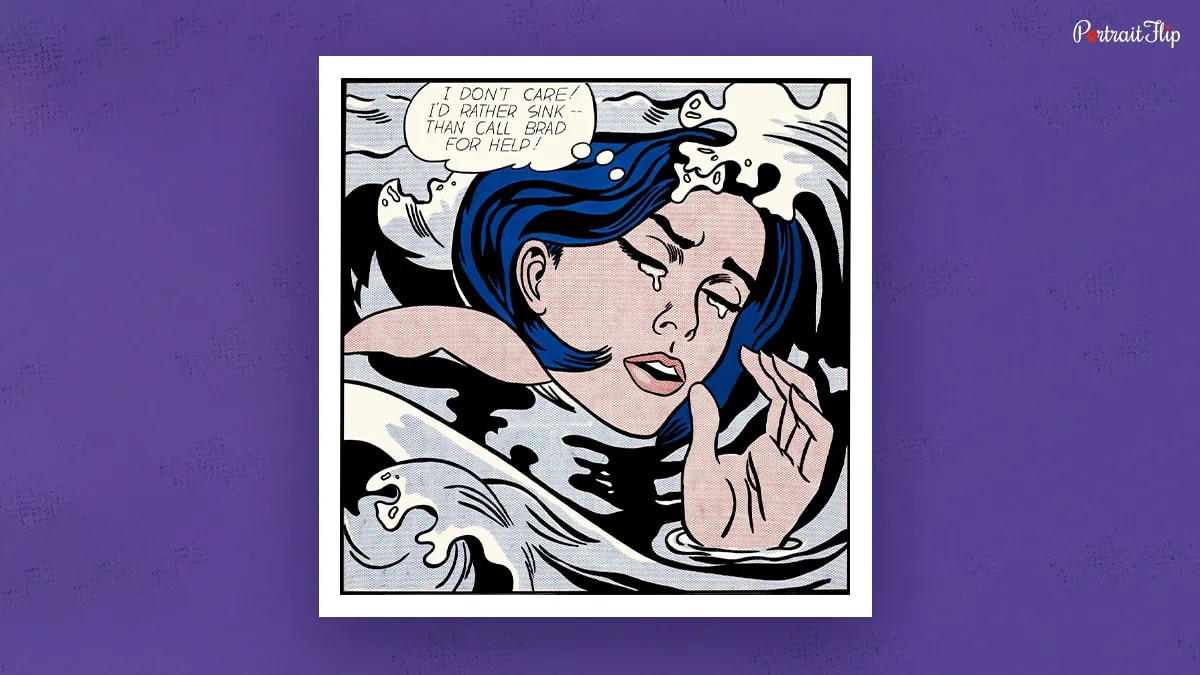
| Artist | Roy Lichtenstein |
| Year | 1963 |
| Dimensions | 171.6 cm × 169.5 cm |
| Medium | Oil and Synthetic Polymer Paint on Canvas |
| Estimated Cost | $95.4 million at Christie’s auction |
| Location | Museum of Modern Art, New York City since 1971 |
“I Do not Care!” is a common nickname for Drowning Girl.
It is one of Lichtenstein’s best-known works.
The piece is regarded as a pillar of his work and essentially marked the demise of Abstract Expressionism as the preeminent movement.
Instead of simply copying the comic strips verbatim, he developed a unique technique to produce fresh and dramatic compositions.
In the original picture, the woman’s boyfriend is shown watching over her from a boat.
Due to the printing technique and the use of speech balloons to convey ideas, this work of pop art has the appearance of a comic book page.
The dialogue in the panel says, “I DON’T CARE! I’D RATHER SINK — THAN CALL BRAD FOR HELP!”
Due to its obvious disconnection from the rest of the story, it gives the play a satirical tone.
“Run for Love!” by DC Comics is a series of Secret Love comic books that serves as its inspiration.
The girl seems to be in a toxic relationship and would rather drown than ask for any help from her partner.
After “Whaam!” Lichtenstein’s painting The Drowning Girl is considered a “masterpiece of melodrama.”
It is up to the viewer to determine whether he was praising or criticizing the comic.
10. President-Elect

| Artist | James Rosenquist |
| Year | 1960 |
| Dimensions | 61 × 91.4 cm |
| Medium | Offset Lithograph on paper (Print) |
| Estimated Cost | $3.3 million at Sotheby (2014) |
| Location | Unknown |
John F. Kennedy, a cake slice from an advertisement, and a yellow Chevrolet are depicted in James Rosenquist’s remarkably left-leaning painting titled “President-elect.”
This collage painting was made with the help of images from their original context and then pieced together to fit a monumental scale.
Do you know why James stuck a propaganda poster of President John F. Kennedy’s face on the wall?
This was because he was fascinated by people who liked to advertise themselves.
And at the time, it was Kennedy’s promise of half a Chevrolet and a stale piece of cake.
This made it one of the most divisive pieces of art that aroused outrage all over the world.
It is regarded as his most important piece of pop art.
If you look at his other works, they demonstrate his preference for persuasion through advertising.
James uses a large-scale piece of art to display his talent for contrasting, fusing, and combining distinct images, which eventually portrays a comprehensive picture.
11. Just What Is It That Makes Today’s Homes So Different, and So Appealing?
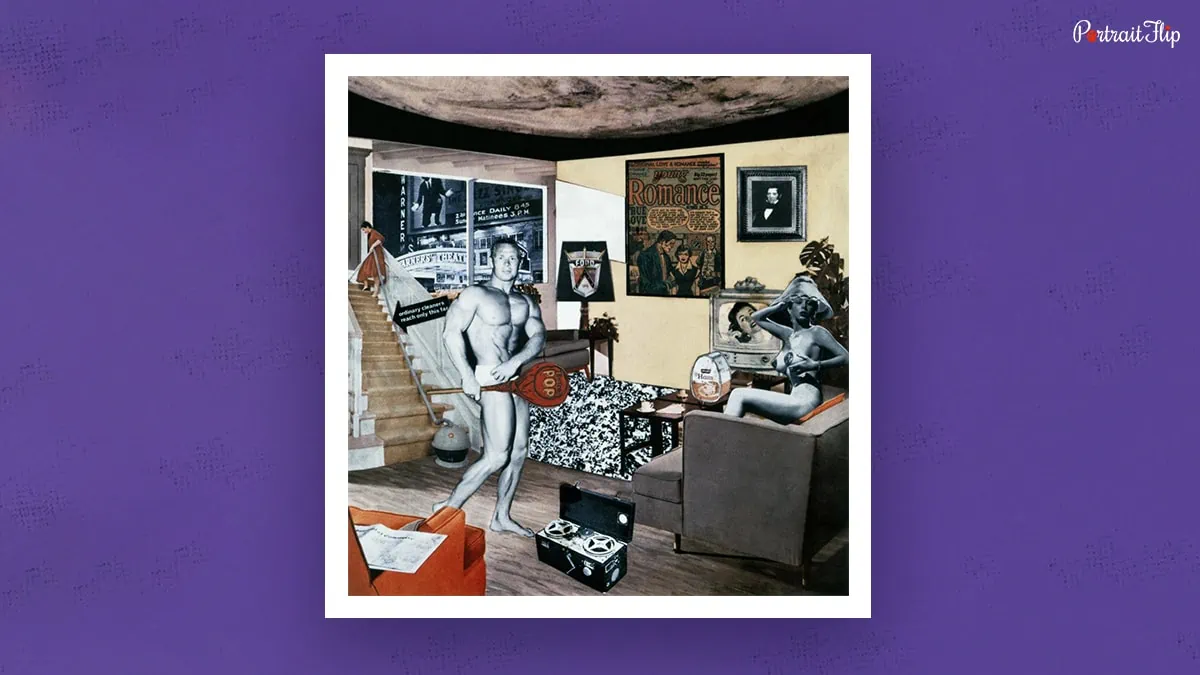
| Artist | Richard Hamilton |
| Year | 1956 |
| Dimensions | 26 cm × 24.8 cm |
| Medium | Collage |
| Estimated Cost | Not Disclosed |
| Location | Kunsthalle Tübingen, Tübingen |
In the art world, it is widely believed that “Just What Is It That Makes Today’s Homes So Different, So Appealing?” is a movement’s foundational work.
Instead of the customary fig leaf, Adam is depicted with his genitalia covered with massive lollipops. Amusing!
The origin of the phrase “Tootsie Pop” as a movement name.
In actuality, as a parody of American advertising, it was the first work of pop art to become recognizable.
By using magazine cutouts, the collage creates the impression of a 1950s lounge.
Adam and Eve wearing contemporary attire in a piece? We all know now why it is one of the most famous pop art paintings.
Numerous elements of the popular mass media and postwar consumerism are all around them.
There is no denying that this work of pop art is satirical.
This satire ridicules the materialism of the mid-20th century industrial and advertising booms.
The pieces for this masterpiece were put together for the 1956 exhibition “This is Tomorrow” at London’s Whitechapel Gallery.
In addition to being featured on advertising posters, it was also promoted in the exhibition book.
12. Flag

| Artist | Jasper Johns |
| Year | 1954-1955 |
| Dimensions | 107.3 cm × 153.8 cm |
| Medium | Encaustic, oil and collage on fabric mounted on plywood |
| Estimated Cost | $110 million |
| Location | Museum of Modern Art, New York |
One of the most sought-after works of pop art by Jasper Johns is called “Flag.”
His contributions to painting, printing, and sculpture have influenced almost every artistic movement.
This ranged from Abstract Expressionism through Neo-Dada to the more contemporary Pop Art movement.
Johns was a painter who contributed to the acceptance of consumer culture in pop art.
He painted flags and maps without including any human subjects in his works.
At the age of 24, Jasper Johns debuted “Flag” in his first solo exhibition.
Supposedly, he had a dream about the American flag that served as his inspiration for the piece of art.
If you notice, only 48 white stars are present because the artwork was produced before more states were added to the flag.
In addition, thirteen stripes in red and white are shown.
The popularity of “Flag” led Johns to create nearly 40 additional works with the American flag as their inspiration.
Johns was happy to use a well-known image because it relieved him of the responsibility of designing.
He used various materials to create this seemingly straightforward but intricate piece.
Panels, paint, and encaustic—a pigment-and-melted-wax mixture that captures the paint’s drips, smears, and brushstrokes—were the materials.
In keeping with the non-political tone of his artwork, his newspaper cuts lacked any headlines.
He concentrated instead on the then-common commercial aspects of printing.
13. Whaam!
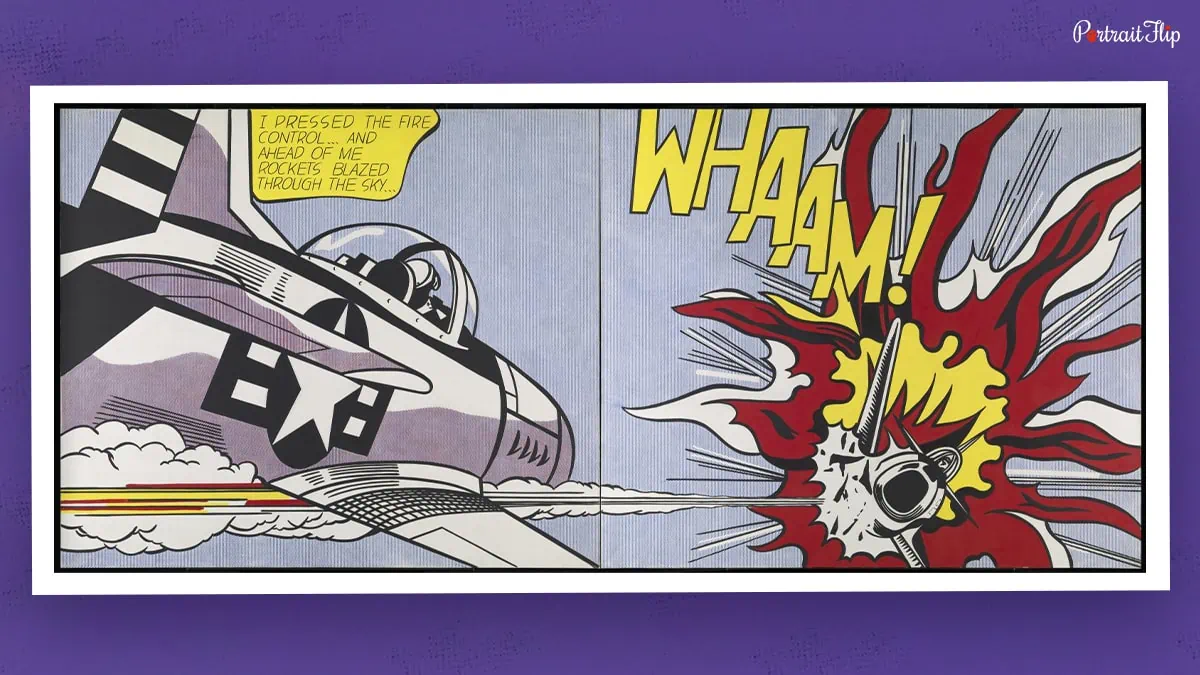
| Artist | Roy Lichtenstein |
| Year | 1963 |
| Dimensions | 172.7 cm × 406.4 cm |
| Medium | Magna acrylic and oil on canvas |
| Estimated Cost | £1,900 and £2,900 |
| Location | Tate Modern, London |
“Whaam!” is a work by the famous American pop artist Roy Lichtenstein.
The piece is just like its title—depicting violence.
You can witness a fighter jet using a missile to bring down another plane.
The entire artwork is rendered in a comic-strip fashion using a limited, primary shade palette and a block color design.
With this printing method, comic books can be created at a minimal cost.
The word bubbles and block letter-sound effects are comical clichés.
Irv Novick’s comic strip from All-American Men of War, served as the source of inspiration for this work.
It records while gently parodying modern America’s conventional hero images.
14. On The Balcony
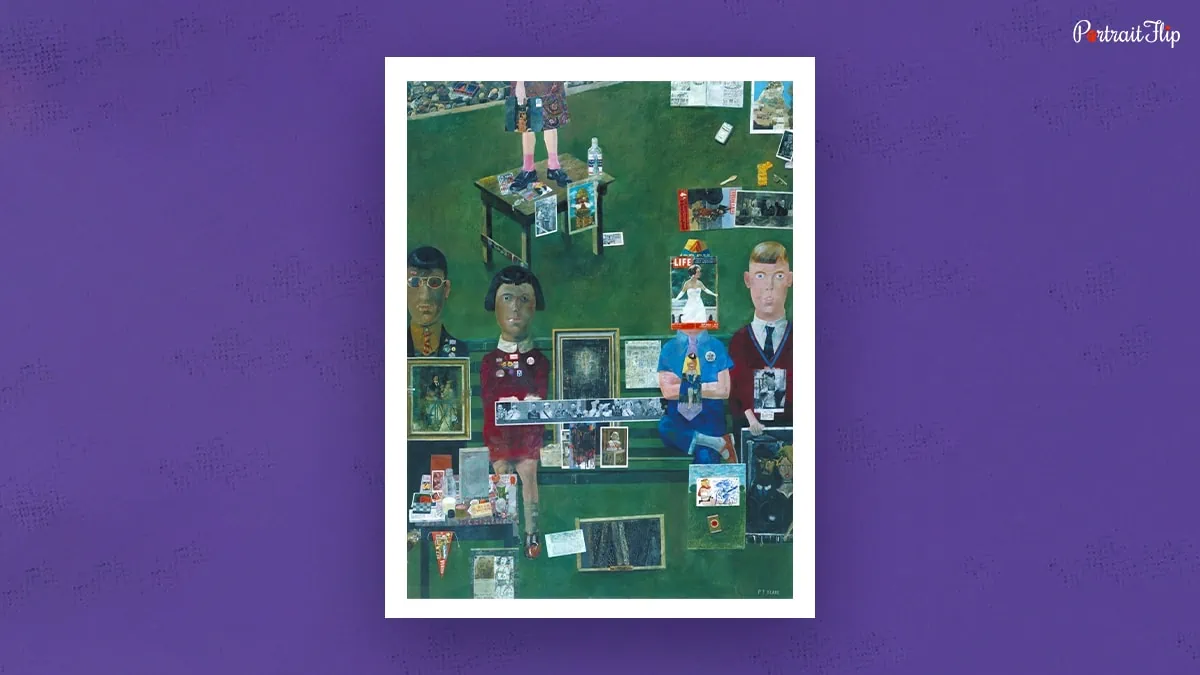
| Artist | Peter Blake |
| Year | 1955-1957 |
| Dimensions | 121 m x 91 m |
| Medium | Oil on Canvas |
| Estimated Cost | Not Disclosed |
| Location | Tate Britain |
Peter Blake is a talented artist who has worked in commercial design, engraving, printing, and sculpture.
Along with traditional fine art, his animated works feature images of wrestlers, music hall performers, movie stars, advertisements, and more.
One of the well-known works of pop art that draws inspiration from Eduard Manet’s “The Balcony” (1868) is this one.
In fact, a boy can be seen holding a copy of it over there on the left.
Despite appearing to be a collage, this well-known work of pop art is entirely painted.
It demonstrates Blake’s unique technique for producing meta-pictures, or paintings of paintings within paintings.
The balcony theme recurs throughout the artwork, with 32 distinct balcony scenarios represented in various photographs, images, and works of art.
The most well-known piece of art by Peter Blake and a classic example of British pop art is “On the Balcony.”
15. Campbell’s Soup Cans
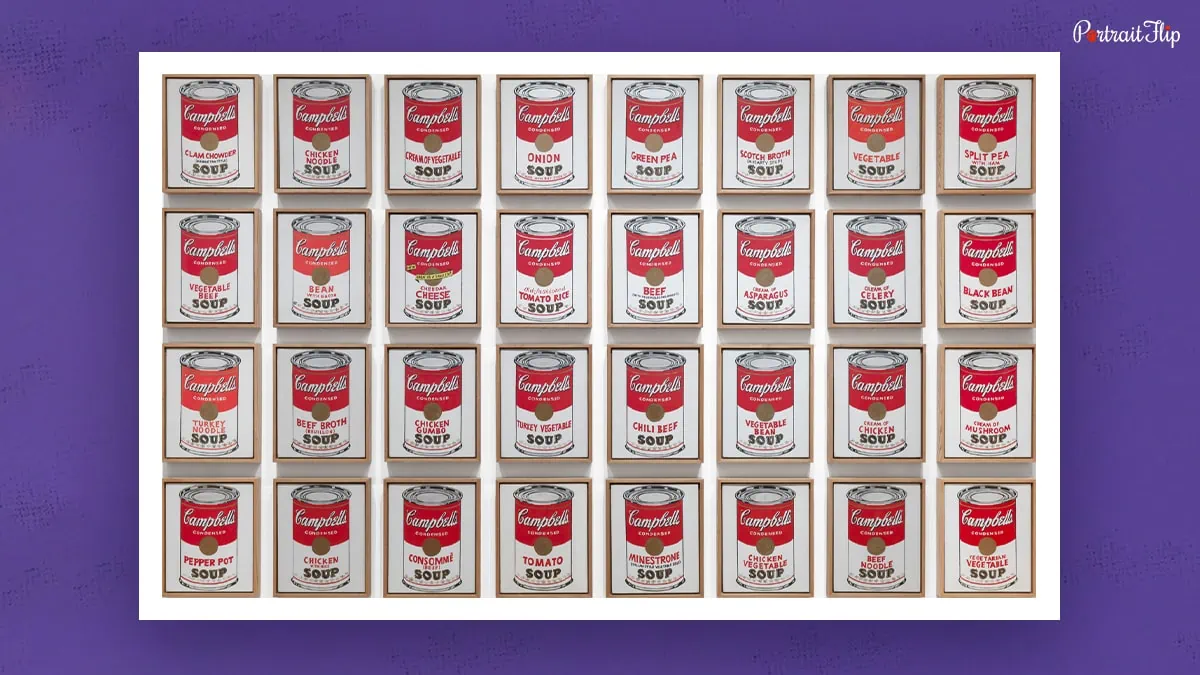
| Artist | Andy Warhol |
| Year | 1962 |
| Dimensions | 20 by 16 inches (51 cm × 41 cm) |
| Medium | Synthetic polymer paint on canvas |
| Estimated Cost | $11.8 million at Christie’s auction (2006) |
| Location | Museum of Modern Art |
“Campbell’s Soup Cans” is a painting that was begun in late 1961 and finished in April of 1962.
It is divided into 32 canvases to resemble a shelf in a grocery store.
All of the cans are uniformly copied onto the canvas using the silkscreen technique, making them all indistinguishable from one another while keeping their distinctive tastes aside.
Campbell’s Soup Cans were a part of Warhol’s first solo show, which he held at the Ferus Gallery in Los Angeles.
By enthusiastic supporters of the abstract movement, this work of art was seen as a jab and disrespect for traditional ideologies.
It was designed to look expressionless, and he loved seeing beauty in things that others might find mundane or conventional.
This is a superb illustration of pop art’s use of the mass-production commercial aesthetic that became its defining characteristic.
His goal was to elevate the commercials of the modern era’s symbols to a higher plane.
This is one of Andy Warhol’s best-known works of pop art, in which he incorporated elitist fine art methods.
Conclusion
These were some of the most talked about artworks from the era of pop art.
Not just the OG pop artists were the ones who claimed the notion of art beyond limits, but there are also a lot of contemporary artists who claim the same.
Pop art paintings have always been associated with an art form that acted as a rebel, as was the artist’s mindset behind creating them.
Does it all tempt you to get a pop art painting for yourself?
Then, don’t stress too much, we’ve got the right options for you!
Author’s Note
If you are still here, then thank you so much for staying till the end!
This was all about the famous pop art paintings.
We try our best to provide you with the most refined and researched information, so if you find this blog helpful, then do leave your valuable feedback in the comments.
See you soon; till then, stay hydrated!
Frequently Asked Questions
Any painting that incorporates everyday objects like soup cans, newspapers, etc. in a very significant way is said to be pop art.
5 famous pop art paintings are: Drowning Girl (Roy Lichtenstein), Campbell’s Soup Cans (Andy Warhol), Look Mickey (Roy Lichtenstein), Radiant Baby (Keith Haring), and Whaam! (Roy Lichtenstein).
Pop art refers to popular culture and art.


